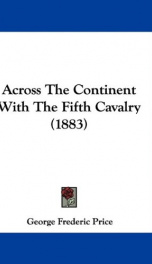across the continent with the fifth cavalry

Purchase of this book includes free trial access to www.million-books.com where you can read more than a million books for free. This is an OCR edition with typos. Excerpt from book: The march from Jefferson Barracks to Texas afforded an excellent school in which to teach horsemanship to the men. While exercise in a riding-hall imparts the theory of horsemanship, which is essential, only time and practice can make good riders, and it is a proverb that good riders will make good raiders. Moreover, in a contest on horseback, it is not the powerful bat the skilful rider who will generally win the victory. The rider who does not know how to manage his horse will surely meet with disaster when he is matched against a rider who does know how to do so. No more forcible illustration of this truth can be found than in the superior skill displayed by the mounted Indians of the West. They are the model irregular light cavalry of North America. Mounted they are everything ; dismounted they are nothing. Their remarkable skill in horsemanship is universally acknowledged. A cavalry recruit should not be assigned to a regiment until he gives promise of making a good rider and knows how to take care of a horse. When the regiment reached its stations in Texas the border was filled with terror. The year 1855 had been one of unusual disaster. The Indians had murdered and pillaged as far down as the Blanco, within twenty miles of Austin, and (in September) even below San Antonio. The arrival of the regiment changed the aspect of affairs, and a vigorous warfare upon the Comanches, illustrated by many successful combats, gave an unwonted security to the settlers. One of the newspapers said, in speaking of Colonel Johnston and the regiment: "We believe we express the common sentiment of our frontier people that no predecessor has given more satisfaction to them, or inspired them with more confidence in the United States army, than this gallant officer and well-known citizen." T... --This text refers to an alternate Paperback edition.
Info about the book
Author:
Series:
Unknown
ISBN:
1117756351
Rating:
4.5/5 (4)Your rating:
0/5
Languge:
English
Users who have this book
Users who want this book
What readers are saying
What do you think? Write your own comment on this book!
write a commentif you like across the continent with the fifth cavalry try:
Other books by this author
Do you want to read a book that interests you? It’s EASY!
Create an account and send a request for reading to other users on the Webpage of the book!

